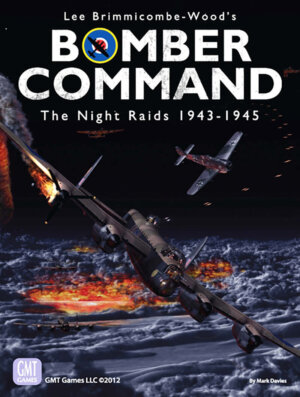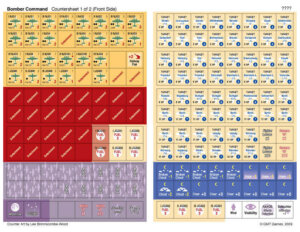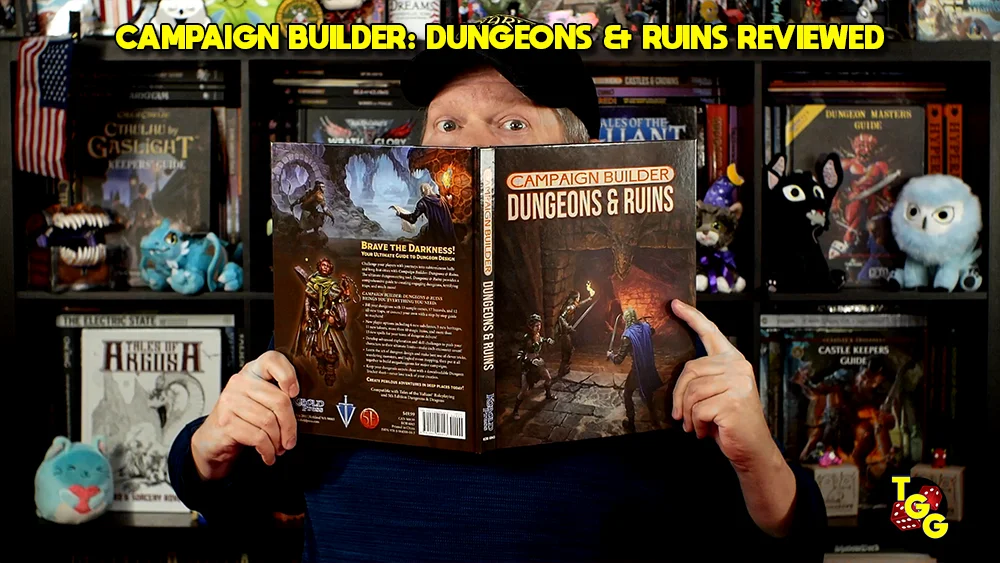
Publisher: GMT Games
Designer: Lee Brimmicombe-Wood
Artists: Lee Brimmicombe-Wood, Rodger B. MacGowan, and Ian Wedge
Year: 2012
Players: Two players
Ages: 15+
Playing Time: Two hours
Genre: WWII aerial bombing raid board game
MSRP: $67.00
Wargames dealing with air combat, or aerial aspects of warfare, have existed for a long time and been some of the most popular titles I’ve ever had in my collection. From the Avalon Hill classics B-17, Air Force, and Flight Leader, to more modern releases such as Down in Flames and Hornet Leader I have to say I’ve always enjoyed a good aerial warfare game and have quite a few in my collection. Note, although it doesn’t fall into the category of a board game, we won’t even talk about how dog-eared Elliott’s , our high school friends Scott and Tim’s, and my very own copies of Ace of Aces ended up.
Now GMT follows up on their recent title, Nightfighter, with another take on the air war over Germany during WWII from designer Lee Brimmicombe-Wood. Bomber Command looks at the night bombing campaign from an operational level as the RAF attempts to hammer the Axis into submission from the air. Unlike the previous GMT title, Night Fighter (NF), Bomber Command (BC) is designed as a true two player game as opposed to the odd set up of NF where the German player was more of a referee than an actual participant. BC is also sort of able to interlock with NF where the plane on plane action can be simulated in depth as opposed to abstracted as it solely is in Bomber Command.
Unfortunately, Bomber Command suffers from a bit of the same one sided involvement issues as Nightfighter previously; More on that in a bit.
Upon opening the box you’ll notice the usual quality associated with GMT releases. From the counters and play aids to the rule book and cards almost everything is top notch. I say “almost” because the two maps included aren’t mounted – not sure why with a $67.00 price point – but they are paper and mainly black (with a bit of an coloration to denote land – which is nearly impossible to differentiate on both maps) so you’ll very easily find color chipping begin to take place along the folded edges almost immediately. It looks to the eye that there was an issue at printing because the map and box cover don’t have as much enough contrast as preproduction photos indicated. As far as the chipping, upon first unfolding the maps from the box there was so much you’d have thought I’d already played the game a good dozen times or so. Unfortunately GMT dropped the ball on the maps since you’ll find the chipping rather distracting and ugly in what is otherwise a pretty flawless presentation. Hopefully GMT will make mounted maps available at a nice price for those who want to repeatedly bring BC to the table.

The main gist of the game breaks down to the location the RAF player chooses for that night’s target. This is done by secretly selecting a chit dependent on the scenario. Obviously the German player will not know the target. Weather plays a factor and there are additional variant rules for even more challenging weather environments as well. The British player will roll to determine the weather conditions in each of the six weather zones.
Each player also has a deck of cards to draw from made up of cards included in both scenarios and other specifically designed for either “Berlin” or “Downfall”. These cards have an enormous effect on how the game will play out and each player will begin each game with five cards in hand.
The RAF player then secretly selects a target for their main raid. At this point the German player may graciously leave the table simply to insure they don’t inadvertently get a glimpse of the chit or notice where the British players eyes seem to focus on the map. This is also where a lot of downtime for the German player crops up as the RAF player now begins to plot the main raid, gardening raids (mining the sea), and Mosquito raids (Luftwaffe airfield attacks) in excruciating detail: 15-20 minutes are devoted to plotting out flight paths to determine what specific hexes RAF air units will enter (and on what turn) as well as making sure raids don’t overlap or end in the same location at the same time.
This is an aspect of BC that I strongly dislike as the German player really has nothing to do during this period of time. Sure, maybe they can sort chits or grab a sandwich but the reality is this is where the design begins to move into the same issues both Elliott and I had with NF: too little for the German player to really do during portions of 
The turn breaks down as follows:
Draw Cards – Both players draw cards to replenish their hands to five cards. Obviously this is from the second turn on.
Nightfighter Move – The German player moves their nightfighters already airborne while also adjusting fuel usage.
Scramble Nightfighters – The German player can put fighters into the air while also rolling for takeoff loses.
Raids Move – The British player removes any previously known raid information from the map and then indicates what where combat may occur due to nightfighters on alert in Himmelbett hexes, flak hexes, and so on. All of this is based on the secret plotting which took place before the game began. The British player will also indicate a target by placing a Bomb Drop counter in which the German player can respond with what is termed a Wild Boar attack.
Detect Raids – The German player attempts to detect raids as well as reestablish contact with previous raids. This information can be rock solid where a raid has to be placed on the map or less definitive based on Tame Boar infiltration.
Tame Boar Infiltration – If a raid is detected in the same hex as a nightfighter unit the German player may conduct a Tame Boar attack on those bombers, or other planes if not the main raid, if they can attach themselves to the raid.
Deploy Nightfighters – The German player may now attach his nightfighters to cities or radio beacons in their current hex which gives them a better chance of infiltrating raids passing through later in the game. Nightfighters can also be assigned to Himmelbett hexes to increase their detection abilities into adjacent hexes.
Recover Nightfighters – Nightfighters low on fuel can be recovered by the German player based on their proximity to their home base. On an interesting side note, many times the Luftwaffe losses where heavier due to mishaps in takeoff and landing than anything related to combat with the enemy…
Bombing – Bombs Dropped counters which were flipped to their Resolve side in the last turn are now gamed on separate generic city maps to determine where the aim point of the bombing was and where the payload struck.
End Turn – The game turn marker is advanced and all Bombs Dropped markers are flipped to their Resolve side.
Keep in mind that the hands of cards the players have come into play during the entire turn and cards can be played at various times throughout depending on the type of card played. These cards can make life easier or more difficult for each player and can even cancel out an opponent’s card play.

All in all, Bomber Command will hold a strong appeal for grognards who want to simulate night bombing over the Reich during the later stages of WWII. This doesn’t mean that I don’t find problems with the game however, beginning with the complexity rating stated on the box; GMT rates this as a six on a scale from one to nine. This ranks it on the higher end of medium complexity according to the company. I think that might have been the case if we were looking at a title back in the days when wargames reigned supreme but for the gaming public at large – even those who may consider themselves die hard grognards – will find this a much more complex undertaking than indicated.
If not for the aforementioned play aid, BC would be one seriously hard nut to crack.
You also want to take into account the early set up stage of BC finds the German player effectively twiddling their thumbs while the British player plots their raids while actual gameplay shifts a lot of the focus to the German player having to make nearly all of the decisions. This isn’t bad, per say, but has to mentioned for those who would be expecting more of a I go/You go back and forth sort of gameplay.
Lastly, a lot of honesty is demanded of the British player as what they’ve previously plotted for their raids determines everything that takes place afterward. I’ve been gaming for over thirty years and understand there are many gamers out there who will *ahem* fudge wherever they can in order to win. Of course I not talking about you dear reader, but I’m sure you know someone in your own gaming gang who might fit that description. Hell, during gameplay of BC the British player may not even be looking to *ahem* fudge but actually make a mistake in plotting – or during raid movement – which will lead to a complete breakdown. To steal a tagline from our friends at Victory Point Games, you’ll want to play with someone who understands “the gameplay’s the thing” taking on the RAF as opposed to a gamer who simply needs to win at all costs for you to appreciate Bomber Command.
In the end I like Bomber Command and I think serious wargamers, who are looking for an extremely solid simulation of night bombing over the Reich, will not be disappointed with BC. Personally, as someone who plays a wide variety of game genres, I have a gut reaction there’s something that feels somewhat unfinished about the design and it’s missing a some of the “fun factor” – as Elliott and I talk about quite a lot – we’ve come to expect from GMT.
[rwp-review id=”0″]
- SOLO BORG is Up for Crowdfunding on Kickstarter - Apr 11, 2025
- Dungeon Crawl Classics: Grave Robbers of Thracia to Land in Stores in May - Apr 11, 2025
- Score Big Savings on the Between Clouds Roleplaying Game - Apr 11, 2025



















Would it be possible to reduce the down time if the RAF player plotted the raid before the gaming session started?
Those are my thoughts exactly Tom.
A well done review, Jeff.